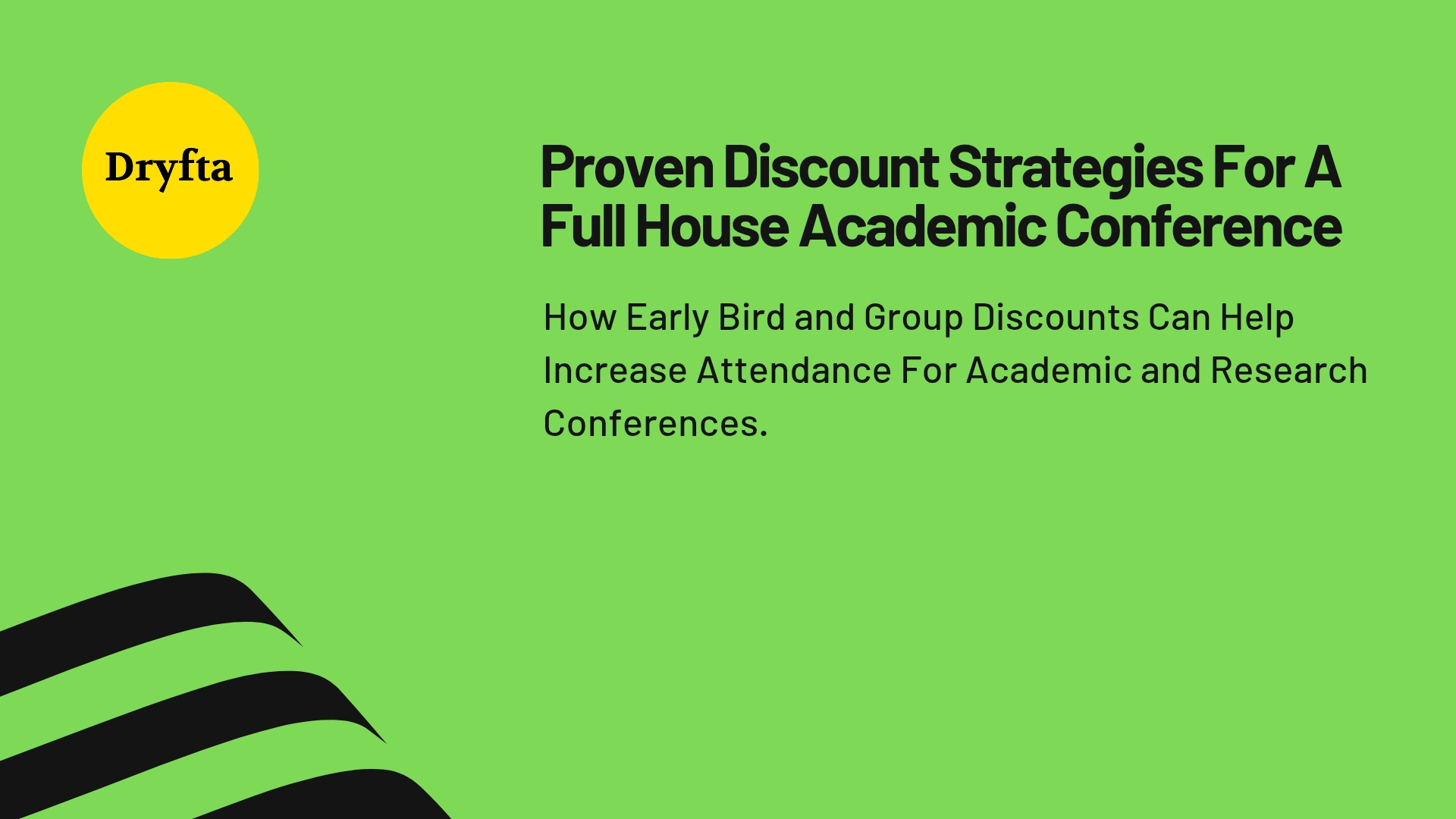
Conference organizers face a curious paradox. They need money upfront to book venues and arrange catering, yet most academics register at the last possible moment. It’s a timing mismatch that has plagued the industry for decades. Cue strategic pricing and specifically, early bird and group discounts.
These are two mechanisms that have quietly revolutionized how academic conferences manage both attendance and finances. But what’s more is the psychology behind these discount offers. It’s a psychological trick, financial cleverness, and competitive weapon all rolled into one pricing strategy. In this blog, let’s unpack how this actually works.
The Psychology Of Why Deadlines Make People Move
Academic professionals live structured lives. Budget approvals happen quarterly and their calendar commitments get locked in months ahead. Conference attendance rarely qualifies as a spontaneous decision.
So what is it that makes someone register for a conference in February when the event doesn’t happen until June? The answer here has a lot to do with behavioral economics, although you don’t need a PhD to understand it. People hate missing out on deals. The technical term for this is loss aversion, the psychological principle that potential losses loom larger than equivalent gains. When you see ‘early bird rate ends Friday,’ your brain processes impending loss more than a discount.
Now adding institutional bureaucracy to the mix, attendees typically need department approval for conference spending. This means they start the registration process weeks before actually completing it. This approval pipeline usually moves at glacial speed. Early bird deadlines help inject urgency into this sluggish system. They create what organizational psychologists call a ‘forcing function’, an external constraint that accelerates internal processes. Suddenly that approval form sitting on someone’s desk for two weeks needs immediate attention. This deadline helps motivate not just attendees but everyone in the approval chain loop.
Academic conference platforms automate these pricing tiers, letting organizers set multiple early bird phases that expire automatically. Technology handles the mechanics and psychology handles motivation. It’s a partnership that works remarkably well.
Group Discounts: Turning Individual Choices Into Collective Decisions
Universities usually don’t send individuals to conferences. Rather, they send teams and groups. This is a distinction that matters more than you might think. If individual registration costs $600 per head for an event, the department faces a $3,000 bill to send everyone. That’s a tough sell to the department chair, who’s already juggling three other funding requests and wondering why conference attendance needs such a hefty line item.
Now with the introduction of group pricing, the per-person cost drops to $450 for groups of five or more. A $750 savings makes the decision far easier for the department to justify. But here’s the fascinating part: the conference actually increases its revenue. Instead of two students attending at $1,200 total, five attend at $2,250. Everyone wins.
You may ask, doesn’t the discount reduce revenue per attendee? Yes. But that’s the wrong metric. Total revenue and total engagement matter more. There’s also a multiplier effect that organizers sometimes overlook. Attendees who come with colleagues stay more engaged throughout the conference. They maintain momentum when they return to their institution because multiple people experienced the same content. Group attendance amplifies impact.
Modern registration systems handle group bookings elegantly. One person registers multiple colleagues via a single transaction. Administrative friction drops dramatically, which removes another barrier to attendance.
Cash Flow: The Advantage That Changes Everything
Let’s talk about money. Specifically, when organizers need it versus when they get it. Conference expenses start months before the event. Traditional pricing models create a nasty cash flow problem: organizers incur expenses for months and revenue arrives in the final weeks before the conference. This timing mismatch forces uncomfortable choices. Organizers either need significant reserves to cover early expenses or negotiate deferred payment terms with vendors. Neither option is ideal. Reserves tie up capital that could fund better events. Deferred payments often come with premium pricing or restrictive terms.
Early bird registrations solve this issue effectively. The cash flow advantage compounds when you club early bird and group discounts. A department registering five people three months early contributes more immediate financial value than ten individuals trickling in during the final week. These early group registrations lay the very foundation for stable financial planning of the event.
Conference management platforms with integrated payment processing track this automatically. Organizers look at real-time dashboards showing collected revenue versus projected attendance and the guesswork disappears. Financial planning becomes data-driven rather than hope-driven.
Predictability: Turning Attendance Projections Into Actual Data
Program committees face a challenging question: how many abstracts should we accept? Accept too few and you risk a sparse program. Accept too many and you’re scrambling for venue space and parallel tracks. This decision usually happens months before the conference, when attendance remains purely speculative. Program chairs make educated guesses based on previous years, trending topics, and optimistic assumptions about registration patterns.
Early bird registrations change this guessing game into better, sturdier decision-making. When 40% of your expected audience registers three months early, you know exactly how much venue capacity you need. The uncertainty that typically haunts conference planning diminishes significantly.
Integrated platforms connect registration systems with abstract management, allowing this data flow to happen automatically. Organizers don’t need separate tools or manual data correlation. The system itself tracks which research areas attract early interest and highlights those insights during planning.
Competitive Differentiation: Standing Out in Crowded Markets
Conferences offering attractive early bird and group discounts understand how academicians make attendance decisions. They respect the institutional budget cycles and help facilitate team participation. These factors matter especially when researchers are juggling multiple conference options.
This also helps a newer conference competing against an established event with strong brand recognition find its breakthrough. The established conference can rely on its reputation, but the newer event needs to make different offerings. Significant early bird savings, such as 30% off standard registration, make attendance financially feasible for researchers who might otherwise default to the traditional option.
The discount reduces perceived risk and increases perceived value. Group discounts are also a valuable addition. Conferences that facilitate group attendance through both pricing and registration processes win these competitive decisions more consistently.
Implementation: Making Strategy Operational
Strategic pricing sounds compelling in theory. It is the implementation that then determines whether it works in practice. Here are a few points to consider:
The discount must be meaningful. A 10% early bird reduction might get noticed, but won’t accelerate decision-making. A 25-30% discount creates genuine urgency that pushes academics to act rather than procrastinate. Group discounts typically range from 15-20%, scaling with group size.
Timing matters enormously. Set early bird deadlines too early and few people have secured institutional approval yet. Set them too late and urgency disappears. The sweet spot for academic conferences typically falls three to four months before the event. This timing matches institutional budget cycles and abstract submission processes.
Multiple early bird tiers work better than single deadlines. A super early bird rate at six months, a standard early bird at three months, and a regular rate thereafter creates multiple decision points that capture different planning styles. Automated systems handle these transitions without manual intervention.
Promotional efforts, if any, must be consistent. The discount means virtually nothing if potential attendees don’t know it exists or forget when it expires.
An Arrow That Doesn’t Miss Its Target
The conferences that treat pricing as a strategic lever that is carefully timed, meaningfully sized, and consistently promoted outperform those using flat pricing models. The difference shows up in registration curves, cash flow statements and attendance numbers. For organizers planning academic conferences, the question isn’t whether to implement strategic pricing. It is whether you can afford not to.
If you’re still weighing your options, you may want to explore Dryfta’s event management platform. A purpose-built online software, Dryfta, is equipped with smart pricing options and early bird discounting strategies. It’s easy to use, fuss-free and helps attain your organizational and research goals. Request a free demonstration today to learn how Dryfta can support your next academic conference and other large-scale events.




